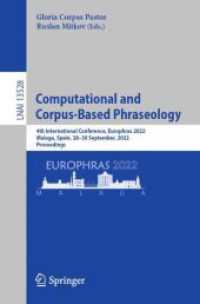Full Description
Epistemic Impressions advances a new history of image-making and art-text relations in classical antiquity. Moving away from a focus on imitation (mimēsis), it looks instead to the concept of the seal-impression (typos), which played a vital role in ancient philosophies of mind: seals were 'epistemic objects' in that they informed complex thinking about the relationship between form, matter, and medium. As an indexically produced image, the typos offered Greek thinkers a model of sense perception and knowledge transmission grounded in material processes of engraving and stamping, which were closely related to those of sculptural moulding and casting (plastikē). In turn, these had a profound influence on concepts of truth, representation, and replication, offering a materially embedded ontology of the image that has far-reaching implications for our understanding of Graeco-Roman aesthetics.
Drawing on theories of media, Verity Platt explores how the concept of impressing (typōsis) was especially significant for literary engagements with artworks, informing Greek models of intermediality from archaic poetry to imperial Greek prose and early Christian exegesis. Advancing an 'object-oriented' approach that dislodges the trope of ekphrasisin favour of embodied processes of making, the book focuses on Hellenistic epigram, an especially medium-conscious genre, offering new readings of poems by the third-century BCE poet Posidippus, who drew on practices of engraving, stamping, and casting in his epigrams on precious gems (Lithika) and bronze statuary (Andriantopoiika). Posidippus' sophisticated engagement with materiality is set within the longer history of intermedial relations in ancient epigram, as these unfold through the Greek Anthologyin dialogue with shifting approaches to image-making and transmission under the Roman Empire and in early Byzantium. As a prehistory of analogue modes of reproduction (and thus the concept of 'type'), Epistemic Impressions demonstrates how, just as many ancient concerns with the visual may seem surprisingly modern, so many modern preoccupations are in fact more ancient than we might presume.
Contents
Introduction: A Genealogy of the Impression
1: The Seal of Polycrates
2: The Stones of Posidippus I: Beyond Mim=esis
3: The Stones of Posidippus II: Elemental Media
4: Bold Hand! Posidippus and the Moulds of Lysippus
5: The Greek Anthology: From Typos to Archetypon
6: Sponge, Foam, and the Chance Impression
Epilogue: Impressing Angels








